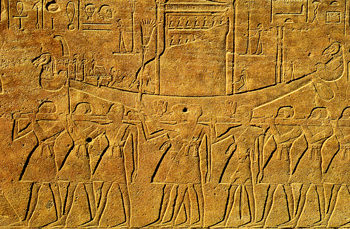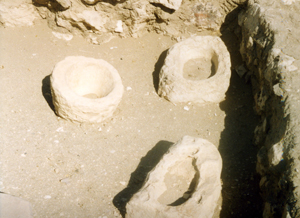
 Amun
AmunAmun was the king of the gods in the New Kingdom. His main temple was Karnak, but the Luxor Temple and Hatshepsut's temple were dedicated to him, plus several others. His name means 'the hidden one'. In the New Kingdom he was joined with the sun god Re to become Amun-Re, the creator god and father of the pharaohs.
Amun was worshipped mainly by the high priest who would look after his cult statue in the inner sanctuary of his temple. The statue would have been made of solid gold - unfortunately none have survived, although we do have some statues of Amun made of gold and silver. The priest would make offerings of incense, food, flowers, wine and beer; he would anoint the statue with perfumes and incense; he would wash it with holy water; and he would clothe it in fine linen. A lector priest would also read out prayers and spells to bring the statue to life and ask it for its blessings.
Amun was shown as a man with two ostrich plumes on his head.
The Beautiful Feast of the Valley
- pa nefer en painet
The Beautiful Feast was a special ceremony to honour Amun. It was one of the only times that Amun got to leave his sanctuary in Karnak (the other was the Opet Festival). The Feast took place in the second month of shemu - the season of harvest before the summer flood. Amun was placed in a shrine in a special gold barque (a boat) and carried by priests, as we see in the picture right. Amun's wife Mut and son Khonsu would have also come along in their own golden barques.
The barques were carried to the Nile with the king following, and placed inside a bigger shrine on a huge boat called Userhat (Strong of Prow). This entire ship was covered with gold leaf and holy symbols. Below is a reconstruction of it.


Userhat was towed over to the west bank and along canals towards Hatshepsut's temple (in later years it was taken to other mortuary temples instead). Here the barque was carried up to the inner sanctuary and placed in a wooden shrine where it was left overnight.
The Valley of the Workmen
The workmen who built the tombs in the Valley of the Kings lived in a special village on the hillside, not far from the farmland. Nowadays we call this place Deir el Medina - back then it was known as The Place of Truth. It was established in the time of Thutmose I and doubled in size in later years. Lots of ostraca (fragments of stone with writing on) have been found from Deir el Medina, giving us a detailed picture of what life was like for them. They worked hard, but liked to drink and enjoy themselves. One even took a day off work because he had had an argument with his wife!
The foundations of the whole village remain today, along with some querns (stone bowls used for grinding grain to make flour - see right) and thousands of pieces of broken pottery. There are also some tombs nearby, including a beautiful one belonging to Sennedjem, after whom I named one of my characters.
